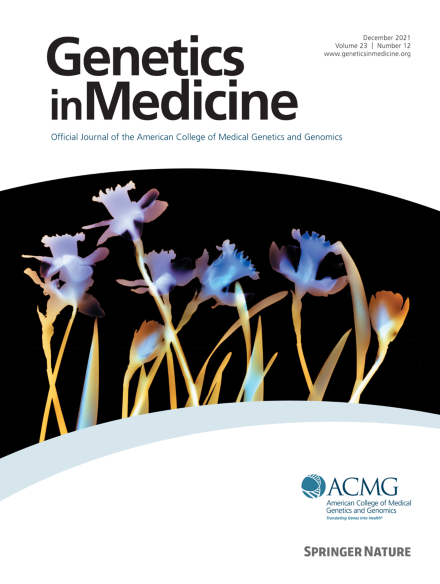在COMPOSE®1/2期随机试验中,pegtibatinase酶替代治疗成人经典同型半胱氨酸尿的安全性和有效性
IF 6.2
1区 医学
Q1 GENETICS & HEREDITY
引用次数: 0
摘要
目的:由于经典的同型半胱氨酸尿(HCU)标准治疗通常无法达到充分的代谢控制,1/2期COMPOSE®试验(NCT03406611)评估了pegtibatinase酶替代疗法。方法:接受标准治疗的12-65岁血浆总同型半胱氨酸(tHcy)升高的HCU患者按3:1随机分为皮下pegtibatinase(≤2.5 mg/kg,每周两次[BIW])或安慰剂的6个增加剂量队列(每个n≈4)。主要终点包括不良事件发生率和免疫原性。次要终点包括它们从基线到治疗后的变化(6-12周的几何平均值)。结果:总共有24名参与者入组。Pegtibatinase在所有剂量下均具有良好的耐受性,无过敏反应或严重的免疫反应;15名参与者(62.5%)经历了≥1个与治疗相关的治疗不良事件(最常见的是注射部位反应;一次严重的[急性荨麻疹])。在两个最高剂量下,治疗后观察到显著的tHcy减少(相对减少:1.5 mg/kg BIW时减少57%;结论:Pegtibatinase总体耐受性良好,可显著降低tHcy水平,显示出治疗HCU的潜力。本文章由计算机程序翻译,如有差异,请以英文原文为准。
Safety and efficacy of pegtibatinase enzyme replacement therapy in adults with classical homocystinuria in the COMPOSE phase 1/2 randomized trial
Purpose
Because the standard-of-care treatment for classical homocystinuria (HCU) often cannot achieve adequate metabolic control, the phase 1/2 COMPOSE trial (NCT03406611) evaluated pegtibatinase enzyme replacement therapy.
Methods
Participants with HCU aged 12 to 65 years with elevated total plasma homocysteine (tHcy) receiving standard-of-care treatment were randomized 3:1 into 6 increasing dose cohorts (each n ≈ 4) of subcutaneous pegtibatinase (≤2.5 mg/kg twice weekly [BIW]) or placebo. Primary end points included adverse event incidence and immunogenicity. Secondary end points included tHcy change from baseline to posttreatment (geometric mean of weeks 6-12).
Results
Overall, 24 participants were enrolled. Pegtibatinase was generally well tolerated at all doses with no anaphylaxis or severe immune reactions; 15 participants (62.5%) experienced ≥1 treatment-related treatment-emergent adverse event (most commonly injection-site reactions; 1 serious [acute urticaria]). At the 2 highest doses, substantial tHcy reductions were observed after treatment (relative reduction: 57% for 1.5 mg/kg BIW; 67% for 2.5 mg/kg BIW), and all participants maintained tHcy < 100 μM. One participant receiving 2.5 mg/kg BIW achieved tHcy < 15 μM (normal) and methionine < 14 μM (below normal), enabling increased dietary intact protein intake. Changes in other metabolites aligned with tHcy.
Conclusion
Pegtibatinase was generally well tolerated and substantially reduced tHcy levels, demonstrating potential as a treatment for HCU.
求助全文
通过发布文献求助,成功后即可免费获取论文全文。
去求助
来源期刊

Genetics in Medicine
医学-遗传学
CiteScore
15.20
自引率
6.80%
发文量
857
审稿时长
1.3 weeks
期刊介绍:
Genetics in Medicine (GIM) is the official journal of the American College of Medical Genetics and Genomics. The journal''s mission is to enhance the knowledge, understanding, and practice of medical genetics and genomics through publications in clinical and laboratory genetics and genomics, including ethical, legal, and social issues as well as public health.
GIM encourages research that combats racism, includes diverse populations and is written by authors from diverse and underrepresented backgrounds.
 求助内容:
求助内容: 应助结果提醒方式:
应助结果提醒方式:


